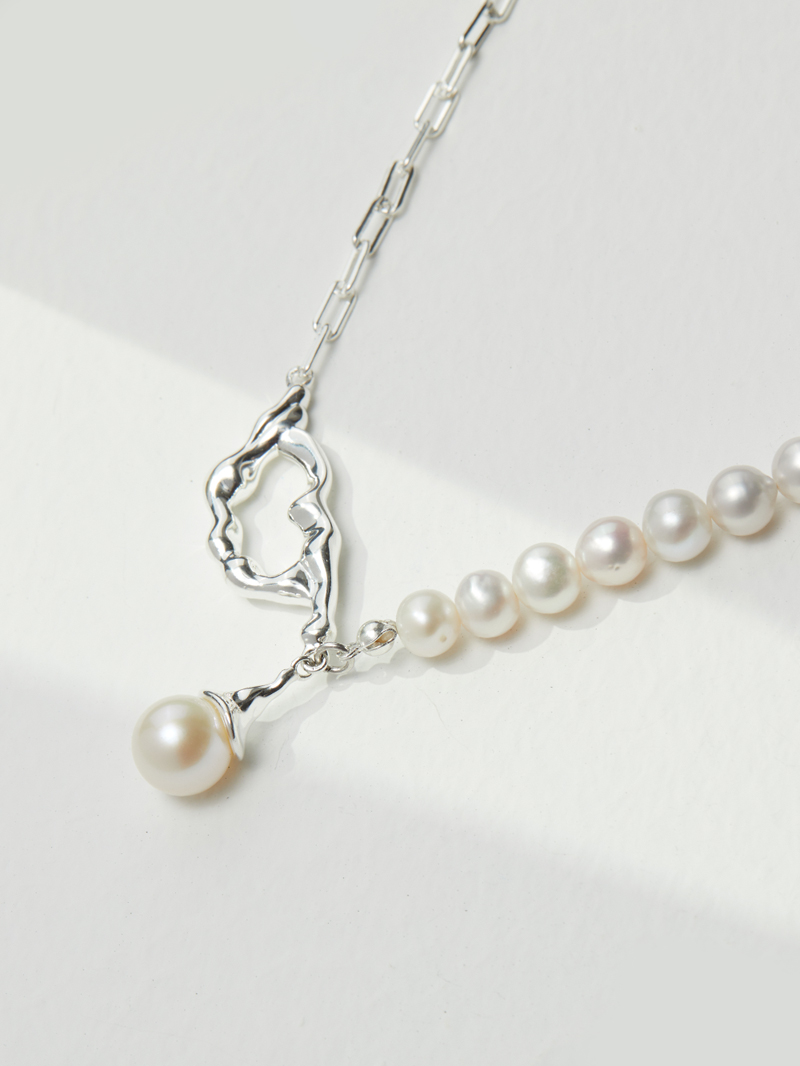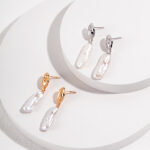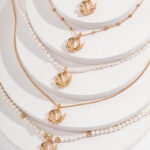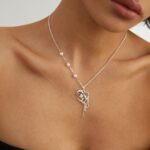Because of their beauty & scarcity, pearls have been prized for centuries. For generations, royalty has worn these glittering gems as heirlooms, adorning their necks, ears, and wrists. Genuine pearl jewelry is not only a gorgeous piece of jewelry but also a wise investment that will likely increase in value over time. We will discuss the various kinds of pearls, how to recognize them, and how to take care of them so they last a lifetime in this blog post. Within oysters and other mollusks, natural pearls are formed.
They develop when an irritant gets inside the mollusk’s shell, like a sand grain or a parasite. To cover the irritant and create a pearl, the mollusk secretes layers of nacre, which is a mixture of protein and calcium carbonate. Pearls that come from this process are rare & priceless, and the process can take years. It’s critical to search for specific traits in order to recognize genuine pearls.
Because they are formed organically, natural pearls frequently have uneven surfaces and irregular shapes. They might also have a lustrous, delicate sheen that is hard to duplicate. Examine a pearl by holding it up to the light to see its color and sheen.
In contrast to imitation pearls, natural pearls frequently have a deeper, richer color. Pearls can be classified as either freshwater or saltwater, & each has special qualities of its own. Pearls that are freshwater are grown in freshwater lakes and rivers, while those that are saltwater are grown in seas and oceans. Because of their bigger size & more dependable shape, saltwater pearls are typically more valuable.
| Topic | Metric |
|---|---|
| Pearl Types | Akoya, Freshwater, South Sea, Tahitian |
| Pearl Size | Measured in millimeters (mm) |
| Pearl Shape | Round, Semi-Round, Button, Drop, Baroque |
| Pearl Luster | Reflectivity and shine of the pearl’s surface |
| Pearl Surface Quality | Presence of blemishes, spots, or other imperfections |
| Pearl Color | Natural colors include white, cream, pink, silver, and black |
| Pearl Matching | Uniformity in size, shape, color, and luster of pearls in a piece of jewelry |
| Pearl Grading | AAA, AA, A, B, C grades based on quality |
| Pearl Care | Proper cleaning and storage to maintain the pearl’s beauty and longevity |
They are highly sought after for their timeless beauty because they are frequently round or nearly round. Oysters like the Tahitian, South Sea, and Akoya produce most saltwater pearls. Freshwater pearls, on the other hand, are frequently less expensive & can be equally stunning. They come in an assortment of sizes, shapes, and colors and are cultivated in mussels. Freshwater pearls have a distinctive and natural appeal because of their ability to take on a round, oval, or uneven shape.
Commonly referred to as imitation or faux pearls, fake pearls have a consistent, glossy surface and are frequently composed of glass or plastic. Even though they might appear real at first, fake pearls can be identified in a few different ways. Searching for flaws is one of the simplest methods to recognize fake pearls. While fake pearls are flawlessly uniform, real pearls frequently have small variations in color and shape. Also, when you rub real pearls against your teeth, they feel grainy, whereas fake pearls feel smooth.
Gently rubbing two pearls together is another method of testing. Since the nacre layers cause friction, real pearls will feel a little bit rough. Conversely, since fake pearls are usually composed of just one material, they will feel smooth. Size, shape, color, luster, and surface quality are some of the elements that affect a pearl’s worth in jewelry.
Because they are rarer & more challenging to grow, larger pearls are typically worth more money. Due to the exact conditions under which they form, round pearls are also extremely valuable. Pearls can be white, black, or any combination of these colors. Pearls with rich, deep colors are frequently worth more than those with paler tones.
Luster is another crucial component, which is the way light reflects off a pearl’s surface. High luster pearls have a dazzling, reflecting sheen that enhances their beauty. A pearl’s surface quality is also taken into account when calculating its value. The value of pearls is higher for those with fewer visible flaws than for those with more. The value of pearl jewelry can also be influenced by the type of pearl’s rarity and the setting’s quality.
The rarity and consequent value of pearls originating from specific oyster species, like Tahitian or South Sea pearls, are higher. The overall value of the piece can also be increased by the craftsmanship and materials chosen for the setting. Bracelets made of natural pearls are a classy and classic piece of jewelry that goes well with many outfits.
A multitude of styles & designs can be achieved by utilizing different types of pearls & settings when creating them. Simple bracelets with round pearls are examples of classic designs. Because of their adaptability, these bracelets go well with both dressy & casual outfits.
Think about bracelets with mixed-type pearls or pearls with asymmetrical shapes for a more contemporary look. These distinctive designs can stand out & lend a sense of individuality. The size, shape, and caliber of the setting should all be taken into account when selecting a natural pearl bracelet. Securing clasps and robust materials that can tolerate regular wear are characteristics of a well-made bracelet. For individuals who want to add a sophisticated touch to their jewelry collection, freshwater pearl rings are a popular option. From straightforward solitaires to intricate cocktail rings, they are available in a multitude of styles.
The size and shape of the pearl should be taken into account when selecting a freshwater pearl ring. Greater size pearls can be the focal point of a statement ring, but smaller pearls are frequently used in delicate, dainty rings. The pearl’s shape can also change, taking on different forms such as round, oval, or uneven. Select a form that goes well with your tastes and personal style.
Apart from the pearl, the fit of the band and the quality of the setting are crucial aspects to take into account. The pearl should be firmly held in place by the setting, which should be composed of sturdy materials. To guarantee a perfect fit, the band needs to be both appropriately sized & comfortable to wear.
A timeless piece of jewelry that works for any occasion are pearl earrings. They give any ensemble a dash of refinement and elegance. A classic option, stud earrings go well with everything. They give off a delicate and elegant appearance thanks to the single pearl that rests near the earlobe.
Stud earrings are a great addition to any jewelry collection because they look good with both formal and casual clothing. Conversely, drop earrings can give an ensemble a glamorous touch. They have a pearl hanging below the earlobe, frequently set with diamonds or other precious stones. For special events or when you want to stand out, drop earrings are ideal.
Think about wearing pearl hoops as earrings for a contemporary take on a timeless look. The striking and distinctive design of these earrings is created by threading pearls onto a hoop. Pearl hoops earrings give a sophisticated touch to any outfit and go well with both formal and casual wear.
A classic and adaptable piece of jewelry, pearl necklaces go well with many different types of clothes. You can find the ideal necklace to fit your style because they are available in a variety of lengths and designs. Simple necklaces with round pearls are examples of classic styles. These necklaces go well with both dressy and casual outfits because they are sophisticated. They can be inherited and are a mainstay of any jewelry collection.
Necklaces with asymmetrical designs or mixed pearl types can look more contemporary. These necklaces can make a statement & offer a dash of uniqueness. If you want to make an impression & show off your individual style, these are ideal. Think about your neckline and personal style when selecting the length of a pearl necklace. Choker-length necklaces go well with off-the-shoulder or V-neck tops because they rest high on the neck. Wearable with a range of necklines, princess-length necklaces rest slightly below the collarbone.
Necklaces that fall between the knees and the bust are ideal for formal & informal settings. Necklaces that are opera length fall beneath the bust & are frequently worn as a statement piece or with formal wear. To ensure its longevity and beauty, pearl jewelry needs to be treated with extra care. The following cleaning and upkeep advice will help you maintain the finest possible appearance for your pearls: Keep your pearl jewelry stored apart from other jewelry to avoid damage and scratches.
Because they are comparatively soft, harder gemstones or metals can easily scratch pearls. – Steer clear of harsh chemicals like hairspray, perfume, and cleaning supplies when handling pearls. These substances have the potential to harm nacre and lessen the pearls’ brilliance. – Use a gentle cloth and light soap to clean your pearls on a regular basis. To eliminate any possible buildup of oil or grime, gently wipe the pearls.
Pearls can be damaged by using harsh cleaners or abrasive materials, so stay away from them. – To keep your pearl jewelry safe from moisture and dust, store it in a jewelry box or soft pouch when not in use. Pearls should not be kept in sealed containers because they require air to retain their brilliance. Your pearl jewelry can be treasured for many generations to come if it is properly maintained. Making an informed choice when buying pearl jewelry and ensuring that it stays a valued and cherished addition to your collection is possible when you are aware of the various types of pearls, how to recognize them, and how to take care of them.






